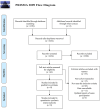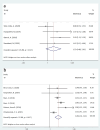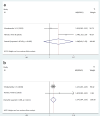Association between night shift work and the risk of type 2 diabetes mellitus: a cohort-based meta-analysis
- PMID: 39696306
- PMCID: PMC11653577
- DOI: 10.1186/s12902-024-01808-w
Association between night shift work and the risk of type 2 diabetes mellitus: a cohort-based meta-analysis
Abstract
Background: The impact of night shift work on the incidence of type 2 diabetes mellitus (T2DM) is not well understood. This meta-analysis assesses the association between night shift work and the risk of developing T2DM and explores this relationship across various subgroups.
Methods: We systematically searched PubMed, Web of Science, EBSCO, and the Cochrane Library from their inception until February 2024. We employed hazard ratios (HR) and 95% confidence intervals (95%CI) to quantify the association between night shift work and T2DM risk.
Results: Our analysis synthesized data from 9 articles encompassing 10 cohort studies. Overall, night shift workers exhibited a 30% increased incidence of T2DM compared to their daytime counterparts (HR = 1.30, 95% CI: [1.18, 1.43], P < 0.001). Among females, night shift workers had a higher incidence of T2DM (HR = 1.28, 95% CI: [1.16, 1.41]); however, in males, the association was not statistically significant (95% CI: [0.89, 2.63]). For individuals with a body mass index (BMI) > 30 kg/m2, night shift work was associated with an increased T2DM risk (HR = 1.14, P = 0.007), whereas there was no significant association for those with a BMI ≤ 30 kg/m2 (P = 0.255). Further, the risk of T2DM increased with longer durations of night shift work; workers with more than 10 years of night shift work faced a higher T2DM risk than those with 10 years or fewer (HR for > 10 years = 1.17, 95% CI: [1.10, 1.24]; HR for ≤ 10 years = 1.06, 95% CI: [1.03, 1.10]).
Conclusion: Findings suggest potential link between night shift work and T2DM risk. Longer durations of night shift work may increase the risk of T2DM. There may be gender differences (greater harm in women, but the male sample size is small) and obesity differences.
Keywords: BMI; Gender; Meta-analysis; Night shift work; Risk; Type 2 diabetes mellitus.
© 2024. The Author(s).
Conflict of interest statement
Declaration. Ethics approval and consent to participate: Not applicable, as this paper is based on research from global databases. Clinical trial number: not applicable. Consent to Publication: Not applicable. Competing interests: The authors declare no competing interests.
Figures





Similar articles
-
Rotating night shift work and risk of type 2 diabetes: two prospective cohort studies in women.PLoS Med. 2011 Dec;8(12):e1001141. doi: 10.1371/journal.pmed.1001141. Epub 2011 Dec 6. PLoS Med. 2011. PMID: 22162955 Free PMC article.
-
Night Shift Work, Genetic Risk, and Type 2 Diabetes in the UK Biobank.Diabetes Care. 2018 Apr;41(4):762-769. doi: 10.2337/dc17-1933. Epub 2018 Feb 12. Diabetes Care. 2018. PMID: 29440150 Free PMC article.
-
Shift work and risk of incident dementia: a study of two population-based cohorts.Eur J Epidemiol. 2018 Oct;33(10):977-987. doi: 10.1007/s10654-018-0430-8. Epub 2018 Aug 3. Eur J Epidemiol. 2018. PMID: 30076495 Free PMC article.
-
Association between shift work and risk of type 2 diabetes mellitus: a systematic review and dose-response meta-analysis of observational studies.Chronobiol Int. 2020 Jan;37(1):29-46. doi: 10.1080/07420528.2019.1683570. Epub 2019 Nov 4. Chronobiol Int. 2020. PMID: 31684766
-
Does the association of prostate cancer with night-shift work differ according to rotating vs. fixed schedule? A systematic review and meta-analysis.Prostate Cancer Prostatic Dis. 2018 Sep;21(3):337-344. doi: 10.1038/s41391-018-0040-2. Epub 2018 Apr 27. Prostate Cancer Prostatic Dis. 2018. PMID: 29700389
Cited by
-
[Live combined Bacillus subtilis and Enterococcus faecium improves glucose and lipid metabolism in type 2 diabetic mice with circadian rhythm disruption via the SCFAs/GPR43/GLP-1 pathway].Nan Fang Yi Ke Da Xue Xue Bao. 2025 Jul 20;45(7):1490-1497. doi: 10.12122/j.issn.1673-4254.2025.07.15. Nan Fang Yi Ke Da Xue Xue Bao. 2025. PMID: 40673311 Free PMC article. Chinese.
-
Unraveling the complex relationship between night shift work and diabetes: exploring mechanisms and potential interventions.Front Public Health. 2025 Jul 25;13:1539679. doi: 10.3389/fpubh.2025.1539679. eCollection 2025. Front Public Health. 2025. PMID: 40786169 Free PMC article. Review.
References
Publication types
MeSH terms
LinkOut - more resources
Full Text Sources
Medical

